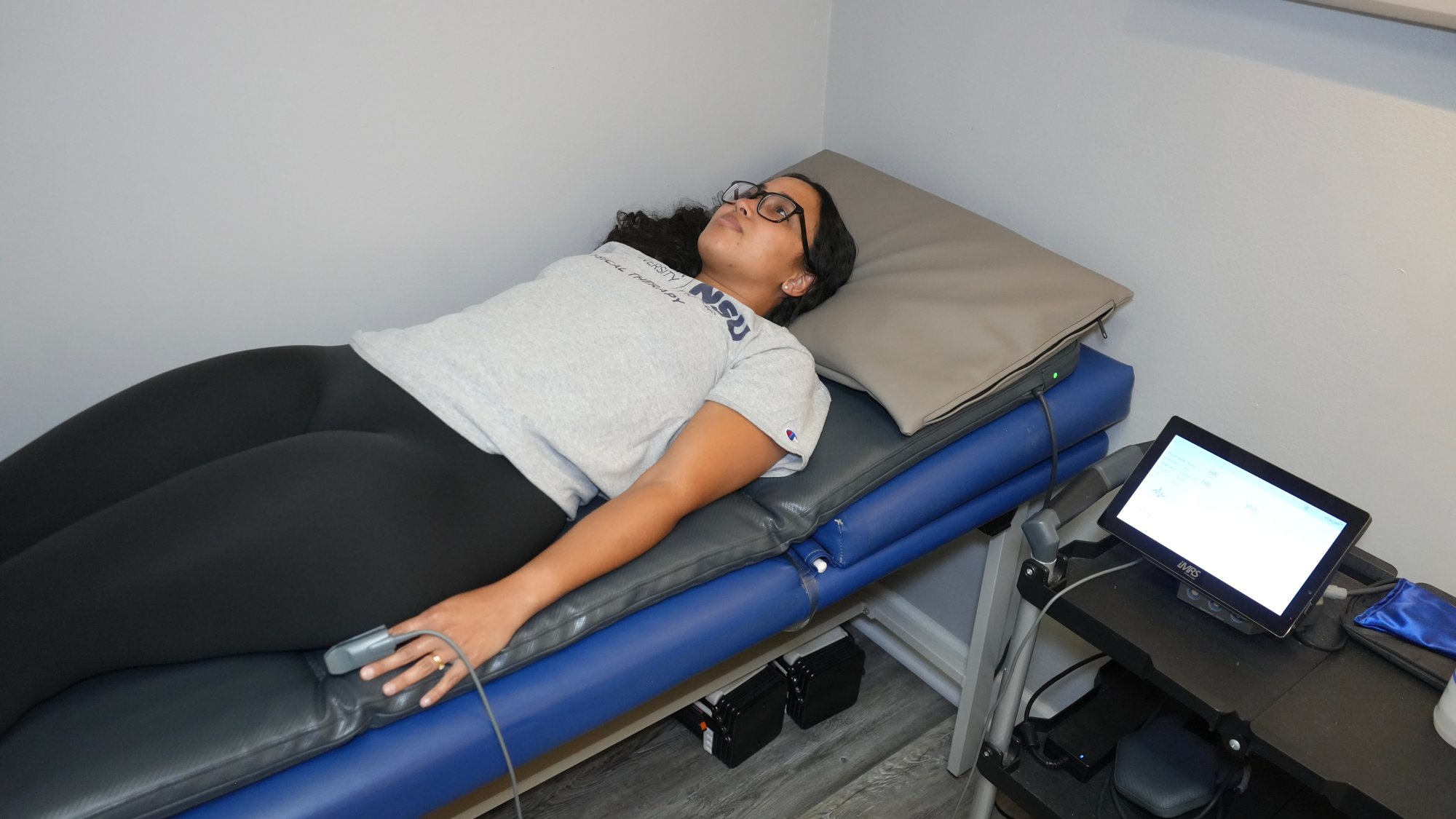Deliver Better Patient Outcomes with Heart Rate Variability (HRV)
Get a real-time assessment of your patients' nervous system state with a non-invasive, 5-minute HRV diagnostic test that outlines a picture of their wellness and recovery capacity by gaining biofeedback from electrical activity of the heart.
Why HRV Matters
HRV goes beyond tracking basic heart rhythms—it taps into the autonomic nervous system to deliver a powerful tool for recovery and optimal health. By measuring heart rate variability (HRV) and using it to inform your physical therapy treatments, you can significantly enhance patient outcomes.
What is Heart Rate Variability (HRV)?
HRV measures the time between heartbeats, offering a window into the body’s autonomic nervous system, including the sympathetic nervous system controlling the body’s “fight or flight” response and the parasympathetic nervous system controlling the “rest and digest” response.
Higher variability signals greater adaptability to stress and improved health. By understanding a patient's HRV, we can tailor treatment protocols that improve their physical and emotional well-being, allowing for a more comprehensive approach to rehabilitation.

Why Physical Therapists Should Add a NeuPT HRV Clinical System to Their Practice
HRV isn’t just about monitoring; it’s about using real-time data to personalize patient care, refine treatment plans and boost recovery rates. Here's why HRV is essential to your practice:
Adds a Cash-Pay Health Assessment Service
Incorporating a NeuPT HRV clinical system (Heart Rate Variability) system into your practice offers an additional revenue stream by providing a valuable cash-pay service. HRV assessments help patients gain insights into their overall health and wellness, making it an attractive option for those seeking proactive healthcare solutions. Patients are willing to pay for services that offer comprehensive, real-time data on their well-being, especially when it’s tied to measurable outcomes that can help guide their treatment plans.
Reduces Stress Levels While Increasing Overall Health & Mental Function
By tracking HRV, therapists can identify patterns in stress levels and nervous system imbalances, leading to more personalized treatment plans. HRV data can guide interventions like biofeedback training, breathing exercises, and targeted physical therapy techniques aimed at reducing stress and improving autonomic balance. Patients will not only see physical improvements but also experience enhanced mental clarity, better sleep, and an overall improvement in quality of life.
Enhances Athletic Performance with HRV
For sports medicine clinics that work with athletes and high-performance individuals, HRV provides a way to fine-tune their training. By tracking how their nervous system responds to various stimuli, HRV can help tailor training programs that avoid injury and promote peak performance. Regular HRV testing can also help an athlete determine the best time of day to exercise in order to get the maximum benefits from a workout (weights, cardio, etc) or other training.
Differentiates You From Your Competition
In an increasingly competitive healthcare market, offering HRV analysis can set your clinic apart from others. While many clinics focus solely on reactive care for injury and pain, adding a cutting-edge HRV system positions you as a leader in preventative health and optimization. This gives your practice a unique selling proposition (USP), attracting a broader client base looking for both rehabilitation, longevity, and optimal health.
Helps Patients “Monitor Their Batteries”
HRV serves as a powerful biofeedback tool that allows patients to track how well their body is coping with stress, fatigue, and recovery. Just like a smartphone battery indicates how much power remains, HRV gives patients a clear picture of their “energy reserves.” This empowers them to take actionable steps to improve their lifestyle and recovery routines, leading to better outcomes. Physical therapists can use this data to guide treatment, ensuring that patients are not overextending themselves during the rehabilitation process.
Satisfied Patients Turn Into Referrals
Satisfied patients are more likely to refer their friends, family, and colleagues, especially when they see significant improvements in both physical and mental health. The HRV system not only helps patients recover more efficiently but also offers them long-term benefits, making them more inclined to spread the word about the unique services you provide. Referrals from happy, healthier patients can drive organic growth and expand your client base, further solidifying your clinic’s reputation for innovative and effective care.
How HRV Works for Physical Therapy
Our state-of-the-art HRV technology uses a combination of sensors and software to measure subtle changes in heart rhythm. This data is analyzed to provide an in-depth view of the patient’s health and to guide the treatment plan. Here's how HRV can be utilized for physical therapy treatment plans:
.png?width=1200&height=960&name=hrv-shop-image%20(1).png)
- Initial Assessment: During the first session, we capture baseline HRV readings to assess autonomic function.
- Integration With Other Physical Therapy Technology: HRV data can be integrated into broader therapeutic technologies like NEUBIE, Winback and PEMF therapies, creating a synergistic approach that amplifies patient recovery. The HRV system works exceptionally well with the NEUBIE “Master Reset” program, which rebalances the autonomic nervous system. This program also offers comprehensive recovery protocols patients are willing to pay for on an ongoing basis.
- Ongoing Monitoring: Regular HRV measurements help guide therapeutic decisions and track progress over time. HRV therapy helps solve the common issue of overexertion during rehabilitation by providing real-time data, ensuring patients recover without setbacks
- Tailored Adjustments: By interpreting HRV data, therapists can fine-tune treatment protocols, ensuring each session aligns with the patient’s current state of health.
HRV Therapy Success Stories
With over 25 years of experience in cutting-edge therapy and innovation, NeuPTTech provides HRV therapy backed by scientific research and technology. Clinics utilizing HRV therapy report improvements in patient outcomes, operational efficiency, and overall satisfaction.
Here's what clinic owners are saying about HRV therapy:
If viewed as a diagnostic tool in the PT space, HRV is the most universally useful assessment tool that I have ever discovered that can and should be considered with 100% of your patients.
– Jason Waz
Unlock the Full Potential of HRV in Your Physical Therapy Practice
Whether you're looking to elevate patient outcomes, increase clinic revenue or enhance your therapeutic offerings, HRV therapy is the tool that can take your clinic to the next level. Check out our frequently asked questions about HRV:
1. How Does HRV Benefit My Patients?
HRV provides insights into how well the body handles stress and recovery, offering a more personalized approach to treatment. Learn How to Use HRV to Create Smarter Treatment Plans.
2. Why is Your HRV Score Important?
Generally speaking, HRV indicates health in a couple of ways. A high HRV score means a stronger Autonomic Nervous System or, simply put, the ability of our bodies to manage day-to-day stressors. On the other hand, as an HRV score is lowered, it may signify high stress and poor health.
3. Why Should I Invest in HRV for My Clinic?
By using HRV, clinics can offer more precise treatments, leading to better patient outcomes, increased satisfaction and higher retention. Learn More About Using the Power of HRV to Elevate Your Practice.
4. How Does NeuPTtech’s Clinical HRV System Compare to Wearables?
While wearables like smartwatches can provide basic HRV (Heart Rate Variability) insights, they often rely on less accurate sensors and algorithms designed for general wellness tracking. NeuPTtech’s system, on the other hand, is developed for physical therapists by physical therapists. We utilize medical-grade sensors and advanced data analytics to deliver detailed insights into autonomic nervous system function. Read More About NeuPTtech’s HRV System Compared to Wearables.
5. How Can HRV Therapy Be Used in Sports Medicine?
HRV therapy helps monitor athletes' recovery, stress levels, and readiness, allowing for more tailored training programs to prevent injury and optimize performance. HRV scores can also help inform your treatment plans to make sure athletes are not overtraining. Read More About How HRV Data Can Be Used To Prevent Overtraining.
6. How Do I Improve My Patient’s HRV?
Stress management, physical therapy interventions like the NEUBIE or PEMF, meditation, diaphragmatic breathing and cardiovascular fitness have been shown to improve heart rate variability over time. This type of training is something that patients can integrate into a physical therapy practice as it encourages cardiovascular health, which is vital to the body’s natural recovery process.
7. How Can I Add HRV Monitoring to my Physical Therapy Practice?
You can integrate HRV by using clinical-grade systems like NeuPTtech’s, which offer easy-to-use software and equipment designed for real-time patient monitoring and customized therapy protocols. Purchase Our Clinical HRV System Here.
Differentiate your practice and stand out from the competition.

Discover incredible ways to improve patient care and business revenue!
- HRV and NEUBIE Master Reset: Concussion Case Study – NeuPTTech
- How Modern Clinicians are Measuring Biological Age Using HRV
- How HRV Improves Your NEUBIE Plan of Care – NeuPTTech
- Heart Rate Variability Frequently Asked Questions
- Maximizing Athletic Performance Through HRV Training
- Are You Screening Your Patients for Heart Rate Variability (HRV)?
- Unleashing the Power of Technology: A PT's Journey with NEUBIE and HRV
- Help Patients Achieve Optimal Health with the NeuPT HRV System – NeuPTTech
